Diary Reflection: Industry 4.0, Leadership & UK Food Industries
VerifiedAdded on 2024/07/04
|9
|3114
|181
Journal and Reflective Writing
AI Summary
This diary reflection explores the impact of Industry 4.0 on the UK food industry, focusing on challenges related to manufacturing, supply chain management, and technological innovation. The reflection draws upon theoretical analysis of concepts like virtualization, IoT, AI, and blockchain, highlighting their role in enhancing operational efficiency and competitiveness. The author, working as a project manager in XYZ corporation, uses Kolb's Reflective Model to analyze personal experiences within the organization, emphasizing the importance of experimental learning and adaptation to changing market demands. The reflection concludes with insights on problem-solving, decision-making, and the role of research and development in driving organizational growth and sustainability.

Diary Reflection
Paraphrase This Document
Need a fresh take? Get an instant paraphrase of this document with our AI Paraphraser
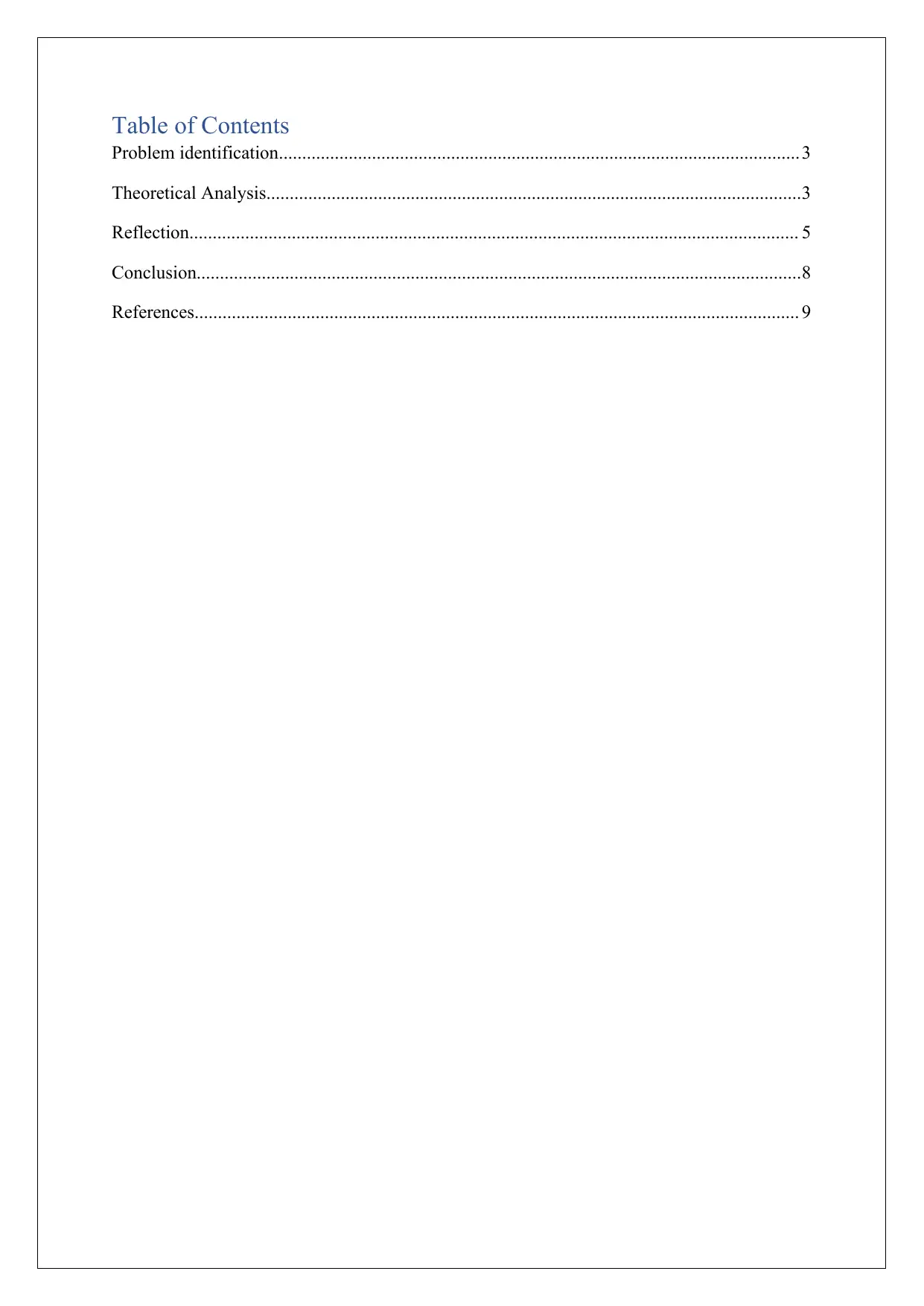
Table of Contents
Problem identification................................................................................................................ 3
Theoretical Analysis...................................................................................................................3
Reflection................................................................................................................................... 5
Conclusion..................................................................................................................................8
References.................................................................................................................................. 9
Problem identification................................................................................................................ 3
Theoretical Analysis...................................................................................................................3
Reflection................................................................................................................................... 5
Conclusion..................................................................................................................................8
References.................................................................................................................................. 9
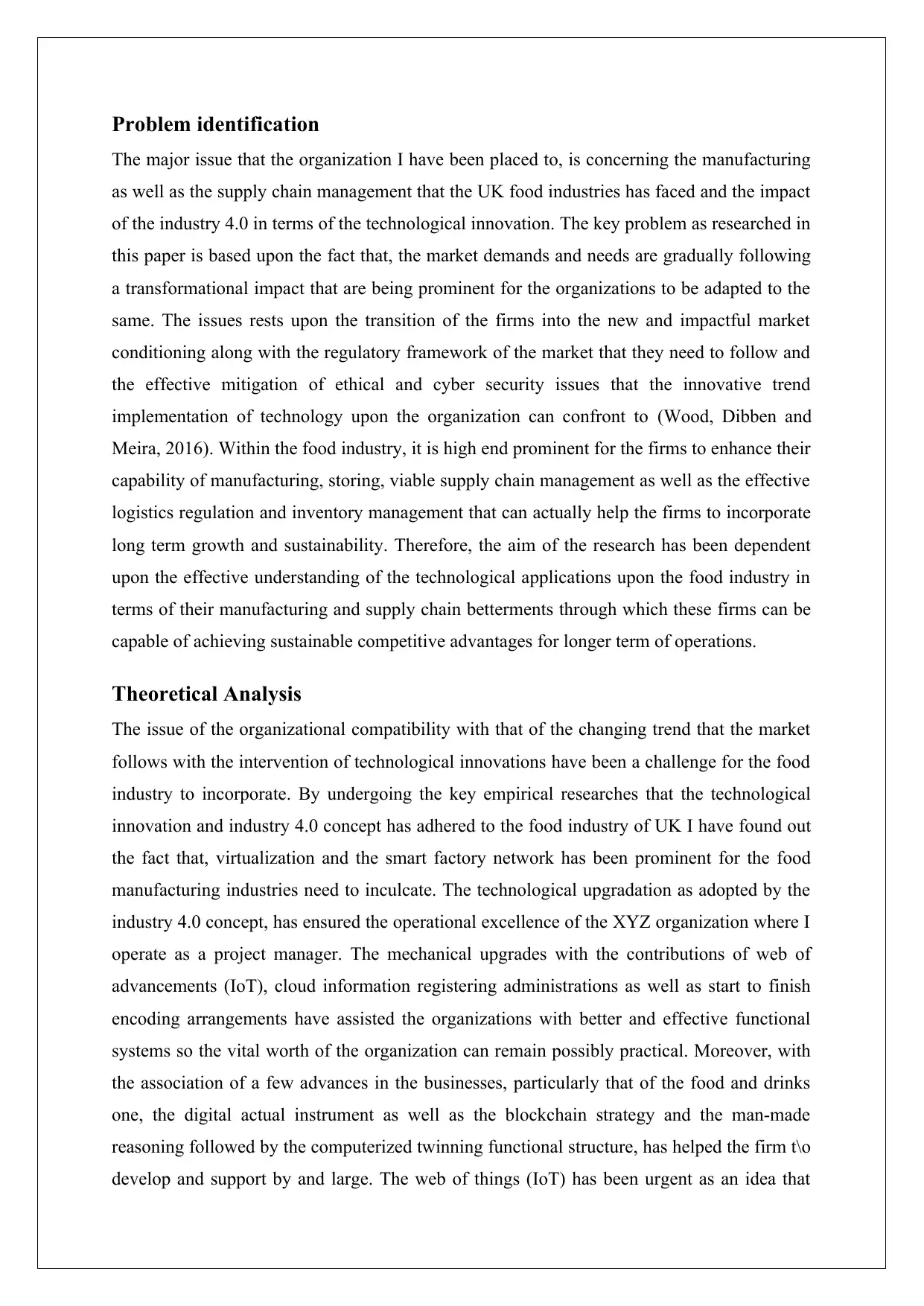
Problem identification
The major issue that the organization I have been placed to, is concerning the manufacturing
as well as the supply chain management that the UK food industries has faced and the impact
of the industry 4.0 in terms of the technological innovation. The key problem as researched in
this paper is based upon the fact that, the market demands and needs are gradually following
a transformational impact that are being prominent for the organizations to be adapted to the
same. The issues rests upon the transition of the firms into the new and impactful market
conditioning along with the regulatory framework of the market that they need to follow and
the effective mitigation of ethical and cyber security issues that the innovative trend
implementation of technology upon the organization can confront to (Wood, Dibben and
Meira, 2016). Within the food industry, it is high end prominent for the firms to enhance their
capability of manufacturing, storing, viable supply chain management as well as the effective
logistics regulation and inventory management that can actually help the firms to incorporate
long term growth and sustainability. Therefore, the aim of the research has been dependent
upon the effective understanding of the technological applications upon the food industry in
terms of their manufacturing and supply chain betterments through which these firms can be
capable of achieving sustainable competitive advantages for longer term of operations.
Theoretical Analysis
The issue of the organizational compatibility with that of the changing trend that the market
follows with the intervention of technological innovations have been a challenge for the food
industry to incorporate. By undergoing the key empirical researches that the technological
innovation and industry 4.0 concept has adhered to the food industry of UK I have found out
the fact that, virtualization and the smart factory network has been prominent for the food
manufacturing industries need to inculcate. The technological upgradation as adopted by the
industry 4.0 concept, has ensured the operational excellence of the XYZ organization where I
operate as a project manager. The mechanical upgrades with the contributions of web of
advancements (IoT), cloud information registering administrations as well as start to finish
encoding arrangements have assisted the organizations with better and effective functional
systems so the vital worth of the organization can remain possibly practical. Moreover, with
the association of a few advances in the businesses, particularly that of the food and drinks
one, the digital actual instrument as well as the blockchain strategy and the man-made
reasoning followed by the computerized twinning functional structure, has helped the firm t\o
develop and support by and large. The web of things (IoT) has been urgent as an idea that
The major issue that the organization I have been placed to, is concerning the manufacturing
as well as the supply chain management that the UK food industries has faced and the impact
of the industry 4.0 in terms of the technological innovation. The key problem as researched in
this paper is based upon the fact that, the market demands and needs are gradually following
a transformational impact that are being prominent for the organizations to be adapted to the
same. The issues rests upon the transition of the firms into the new and impactful market
conditioning along with the regulatory framework of the market that they need to follow and
the effective mitigation of ethical and cyber security issues that the innovative trend
implementation of technology upon the organization can confront to (Wood, Dibben and
Meira, 2016). Within the food industry, it is high end prominent for the firms to enhance their
capability of manufacturing, storing, viable supply chain management as well as the effective
logistics regulation and inventory management that can actually help the firms to incorporate
long term growth and sustainability. Therefore, the aim of the research has been dependent
upon the effective understanding of the technological applications upon the food industry in
terms of their manufacturing and supply chain betterments through which these firms can be
capable of achieving sustainable competitive advantages for longer term of operations.
Theoretical Analysis
The issue of the organizational compatibility with that of the changing trend that the market
follows with the intervention of technological innovations have been a challenge for the food
industry to incorporate. By undergoing the key empirical researches that the technological
innovation and industry 4.0 concept has adhered to the food industry of UK I have found out
the fact that, virtualization and the smart factory network has been prominent for the food
manufacturing industries need to inculcate. The technological upgradation as adopted by the
industry 4.0 concept, has ensured the operational excellence of the XYZ organization where I
operate as a project manager. The mechanical upgrades with the contributions of web of
advancements (IoT), cloud information registering administrations as well as start to finish
encoding arrangements have assisted the organizations with better and effective functional
systems so the vital worth of the organization can remain possibly practical. Moreover, with
the association of a few advances in the businesses, particularly that of the food and drinks
one, the digital actual instrument as well as the blockchain strategy and the man-made
reasoning followed by the computerized twinning functional structure, has helped the firm t\o
develop and support by and large. The web of things (IoT) has been urgent as an idea that
⊘ This is a preview!⊘
Do you want full access?
Subscribe today to unlock all pages.

Trusted by 1+ million students worldwide
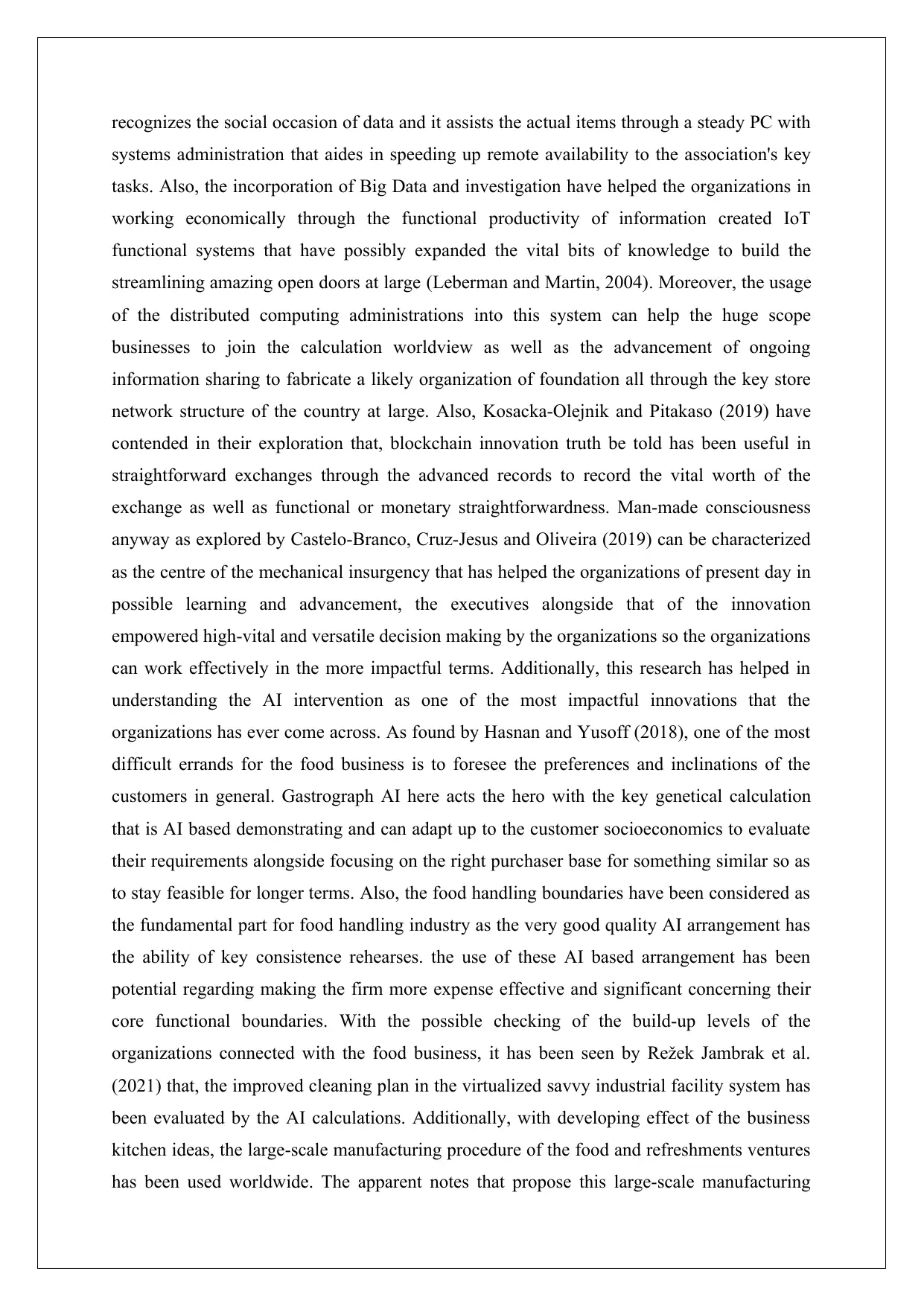
recognizes the social occasion of data and it assists the actual items through a steady PC with
systems administration that aides in speeding up remote availability to the association's key
tasks. Also, the incorporation of Big Data and investigation have helped the organizations in
working economically through the functional productivity of information created IoT
functional systems that have possibly expanded the vital bits of knowledge to build the
streamlining amazing open doors at large (Leberman and Martin, 2004). Moreover, the usage
of the distributed computing administrations into this system can help the huge scope
businesses to join the calculation worldview as well as the advancement of ongoing
information sharing to fabricate a likely organization of foundation all through the key store
network structure of the country at large. Also, Kosacka-Olejnik and Pitakaso (2019) have
contended in their exploration that, blockchain innovation truth be told has been useful in
straightforward exchanges through the advanced records to record the vital worth of the
exchange as well as functional or monetary straightforwardness. Man-made consciousness
anyway as explored by Castelo-Branco, Cruz-Jesus and Oliveira (2019) can be characterized
as the centre of the mechanical insurgency that has helped the organizations of present day in
possible learning and advancement, the executives alongside that of the innovation
empowered high-vital and versatile decision making by the organizations so the organizations
can work effectively in the more impactful terms. Additionally, this research has helped in
understanding the AI intervention as one of the most impactful innovations that the
organizations has ever come across. As found by Hasnan and Yusoff (2018), one of the most
difficult errands for the food business is to foresee the preferences and inclinations of the
customers in general. Gastrograph AI here acts the hero with the key genetical calculation
that is AI based demonstrating and can adapt up to the customer socioeconomics to evaluate
their requirements alongside focusing on the right purchaser base for something similar so as
to stay feasible for longer terms. Also, the food handling boundaries have been considered as
the fundamental part for food handling industry as the very good quality AI arrangement has
the ability of key consistence rehearses. the use of these AI based arrangement has been
potential regarding making the firm more expense effective and significant concerning their
core functional boundaries. With the possible checking of the build-up levels of the
organizations connected with the food business, it has been seen by Režek Jambrak et al.
(2021) that, the improved cleaning plan in the virtualized savvy industrial facility system has
been evaluated by the AI calculations. Additionally, with developing effect of the business
kitchen ideas, the large-scale manufacturing procedure of the food and refreshments ventures
has been used worldwide. The apparent notes that propose this large-scale manufacturing
systems administration that aides in speeding up remote availability to the association's key
tasks. Also, the incorporation of Big Data and investigation have helped the organizations in
working economically through the functional productivity of information created IoT
functional systems that have possibly expanded the vital bits of knowledge to build the
streamlining amazing open doors at large (Leberman and Martin, 2004). Moreover, the usage
of the distributed computing administrations into this system can help the huge scope
businesses to join the calculation worldview as well as the advancement of ongoing
information sharing to fabricate a likely organization of foundation all through the key store
network structure of the country at large. Also, Kosacka-Olejnik and Pitakaso (2019) have
contended in their exploration that, blockchain innovation truth be told has been useful in
straightforward exchanges through the advanced records to record the vital worth of the
exchange as well as functional or monetary straightforwardness. Man-made consciousness
anyway as explored by Castelo-Branco, Cruz-Jesus and Oliveira (2019) can be characterized
as the centre of the mechanical insurgency that has helped the organizations of present day in
possible learning and advancement, the executives alongside that of the innovation
empowered high-vital and versatile decision making by the organizations so the organizations
can work effectively in the more impactful terms. Additionally, this research has helped in
understanding the AI intervention as one of the most impactful innovations that the
organizations has ever come across. As found by Hasnan and Yusoff (2018), one of the most
difficult errands for the food business is to foresee the preferences and inclinations of the
customers in general. Gastrograph AI here acts the hero with the key genetical calculation
that is AI based demonstrating and can adapt up to the customer socioeconomics to evaluate
their requirements alongside focusing on the right purchaser base for something similar so as
to stay feasible for longer terms. Also, the food handling boundaries have been considered as
the fundamental part for food handling industry as the very good quality AI arrangement has
the ability of key consistence rehearses. the use of these AI based arrangement has been
potential regarding making the firm more expense effective and significant concerning their
core functional boundaries. With the possible checking of the build-up levels of the
organizations connected with the food business, it has been seen by Režek Jambrak et al.
(2021) that, the improved cleaning plan in the virtualized savvy industrial facility system has
been evaluated by the AI calculations. Additionally, with developing effect of the business
kitchen ideas, the large-scale manufacturing procedure of the food and refreshments ventures
has been used worldwide. The apparent notes that propose this large-scale manufacturing
Paraphrase This Document
Need a fresh take? Get an instant paraphrase of this document with our AI Paraphraser
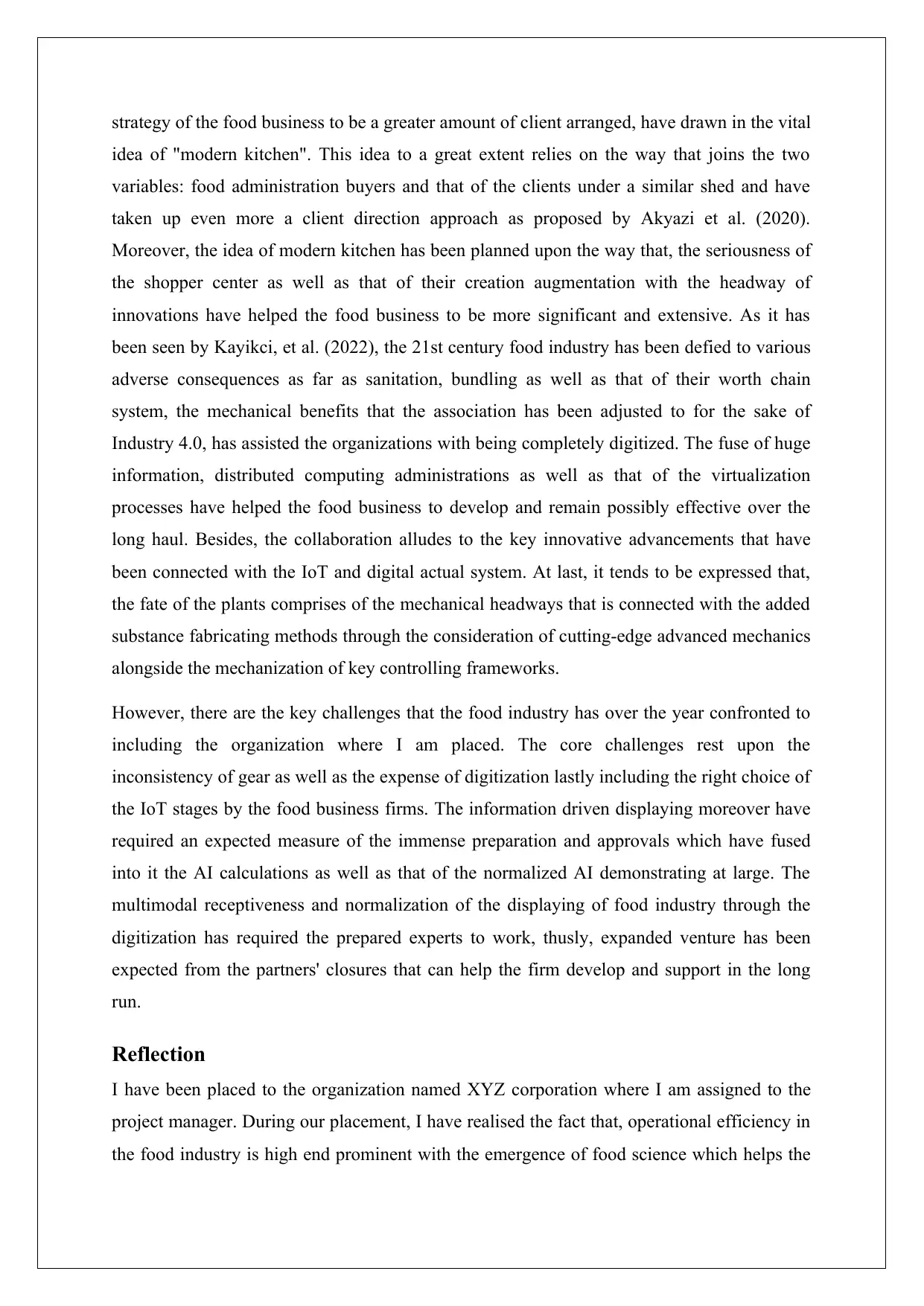
strategy of the food business to be a greater amount of client arranged, have drawn in the vital
idea of "modern kitchen". This idea to a great extent relies on the way that joins the two
variables: food administration buyers and that of the clients under a similar shed and have
taken up even more a client direction approach as proposed by Akyazi et al. (2020).
Moreover, the idea of modern kitchen has been planned upon the way that, the seriousness of
the shopper center as well as that of their creation augmentation with the headway of
innovations have helped the food business to be more significant and extensive. As it has
been seen by Kayikci, et al. (2022), the 21st century food industry has been defied to various
adverse consequences as far as sanitation, bundling as well as that of their worth chain
system, the mechanical benefits that the association has been adjusted to for the sake of
Industry 4.0, has assisted the organizations with being completely digitized. The fuse of huge
information, distributed computing administrations as well as that of the virtualization
processes have helped the food business to develop and remain possibly effective over the
long haul. Besides, the collaboration alludes to the key innovative advancements that have
been connected with the IoT and digital actual system. At last, it tends to be expressed that,
the fate of the plants comprises of the mechanical headways that is connected with the added
substance fabricating methods through the consideration of cutting-edge advanced mechanics
alongside the mechanization of key controlling frameworks.
However, there are the key challenges that the food industry has over the year confronted to
including the organization where I am placed. The core challenges rest upon the
inconsistency of gear as well as the expense of digitization lastly including the right choice of
the IoT stages by the food business firms. The information driven displaying moreover have
required an expected measure of the immense preparation and approvals which have fused
into it the AI calculations as well as that of the normalized AI demonstrating at large. The
multimodal receptiveness and normalization of the displaying of food industry through the
digitization has required the prepared experts to work, thusly, expanded venture has been
expected from the partners' closures that can help the firm develop and support in the long
run.
Reflection
I have been placed to the organization named XYZ corporation where I am assigned to the
project manager. During our placement, I have realised the fact that, operational efficiency in
the food industry is high end prominent with the emergence of food science which helps the
idea of "modern kitchen". This idea to a great extent relies on the way that joins the two
variables: food administration buyers and that of the clients under a similar shed and have
taken up even more a client direction approach as proposed by Akyazi et al. (2020).
Moreover, the idea of modern kitchen has been planned upon the way that, the seriousness of
the shopper center as well as that of their creation augmentation with the headway of
innovations have helped the food business to be more significant and extensive. As it has
been seen by Kayikci, et al. (2022), the 21st century food industry has been defied to various
adverse consequences as far as sanitation, bundling as well as that of their worth chain
system, the mechanical benefits that the association has been adjusted to for the sake of
Industry 4.0, has assisted the organizations with being completely digitized. The fuse of huge
information, distributed computing administrations as well as that of the virtualization
processes have helped the food business to develop and remain possibly effective over the
long haul. Besides, the collaboration alludes to the key innovative advancements that have
been connected with the IoT and digital actual system. At last, it tends to be expressed that,
the fate of the plants comprises of the mechanical headways that is connected with the added
substance fabricating methods through the consideration of cutting-edge advanced mechanics
alongside the mechanization of key controlling frameworks.
However, there are the key challenges that the food industry has over the year confronted to
including the organization where I am placed. The core challenges rest upon the
inconsistency of gear as well as the expense of digitization lastly including the right choice of
the IoT stages by the food business firms. The information driven displaying moreover have
required an expected measure of the immense preparation and approvals which have fused
into it the AI calculations as well as that of the normalized AI demonstrating at large. The
multimodal receptiveness and normalization of the displaying of food industry through the
digitization has required the prepared experts to work, thusly, expanded venture has been
expected from the partners' closures that can help the firm develop and support in the long
run.
Reflection
I have been placed to the organization named XYZ corporation where I am assigned to the
project manager. During our placement, I have realised the fact that, operational efficiency in
the food industry is high end prominent with the emergence of food science which helps the
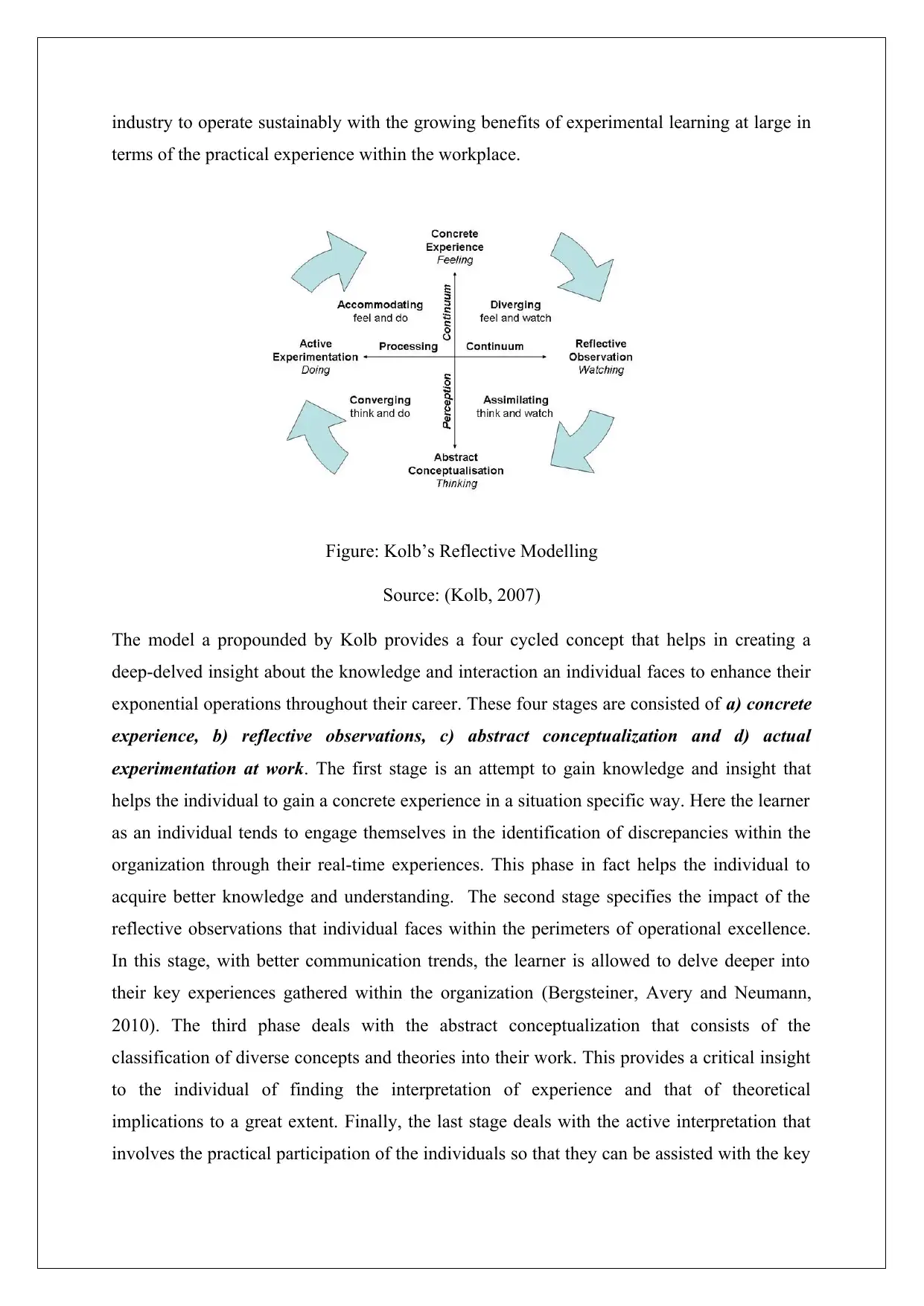
industry to operate sustainably with the growing benefits of experimental learning at large in
terms of the practical experience within the workplace.
Figure: Kolb’s Reflective Modelling
Source: (Kolb, 2007)
The model a propounded by Kolb provides a four cycled concept that helps in creating a
deep-delved insight about the knowledge and interaction an individual faces to enhance their
exponential operations throughout their career. These four stages are consisted of a) concrete
experience, b) reflective observations, c) abstract conceptualization and d) actual
experimentation at work. The first stage is an attempt to gain knowledge and insight that
helps the individual to gain a concrete experience in a situation specific way. Here the learner
as an individual tends to engage themselves in the identification of discrepancies within the
organization through their real-time experiences. This phase in fact helps the individual to
acquire better knowledge and understanding. The second stage specifies the impact of the
reflective observations that individual faces within the perimeters of operational excellence.
In this stage, with better communication trends, the learner is allowed to delve deeper into
their key experiences gathered within the organization (Bergsteiner, Avery and Neumann,
2010). The third phase deals with the abstract conceptualization that consists of the
classification of diverse concepts and theories into their work. This provides a critical insight
to the individual of finding the interpretation of experience and that of theoretical
implications to a great extent. Finally, the last stage deals with the active interpretation that
involves the practical participation of the individuals so that they can be assisted with the key
terms of the practical experience within the workplace.
Figure: Kolb’s Reflective Modelling
Source: (Kolb, 2007)
The model a propounded by Kolb provides a four cycled concept that helps in creating a
deep-delved insight about the knowledge and interaction an individual faces to enhance their
exponential operations throughout their career. These four stages are consisted of a) concrete
experience, b) reflective observations, c) abstract conceptualization and d) actual
experimentation at work. The first stage is an attempt to gain knowledge and insight that
helps the individual to gain a concrete experience in a situation specific way. Here the learner
as an individual tends to engage themselves in the identification of discrepancies within the
organization through their real-time experiences. This phase in fact helps the individual to
acquire better knowledge and understanding. The second stage specifies the impact of the
reflective observations that individual faces within the perimeters of operational excellence.
In this stage, with better communication trends, the learner is allowed to delve deeper into
their key experiences gathered within the organization (Bergsteiner, Avery and Neumann,
2010). The third phase deals with the abstract conceptualization that consists of the
classification of diverse concepts and theories into their work. This provides a critical insight
to the individual of finding the interpretation of experience and that of theoretical
implications to a great extent. Finally, the last stage deals with the active interpretation that
involves the practical participation of the individuals so that they can be assisted with the key
⊘ This is a preview!⊘
Do you want full access?
Subscribe today to unlock all pages.

Trusted by 1+ million students worldwide
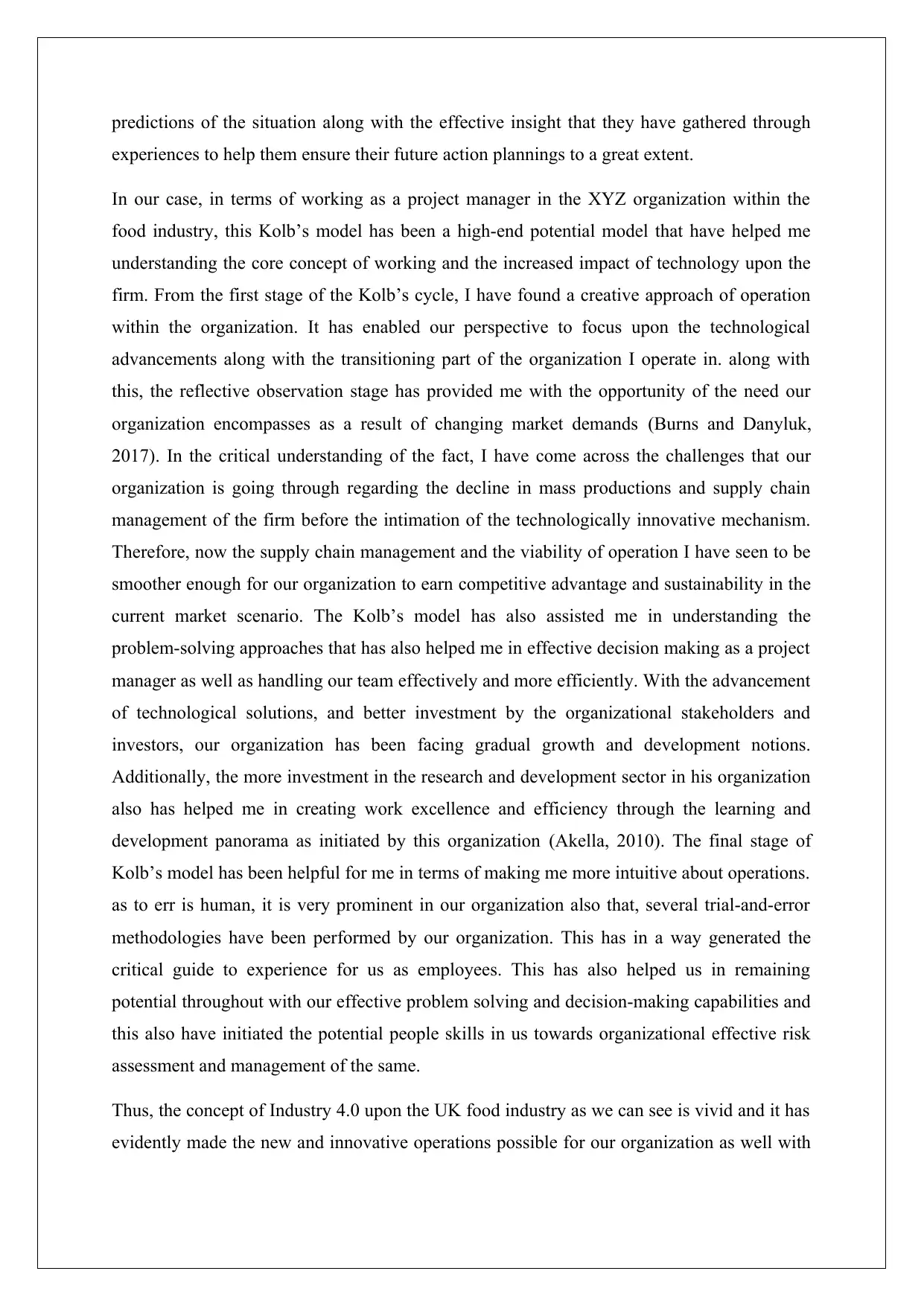
predictions of the situation along with the effective insight that they have gathered through
experiences to help them ensure their future action plannings to a great extent.
In our case, in terms of working as a project manager in the XYZ organization within the
food industry, this Kolb’s model has been a high-end potential model that have helped me
understanding the core concept of working and the increased impact of technology upon the
firm. From the first stage of the Kolb’s cycle, I have found a creative approach of operation
within the organization. It has enabled our perspective to focus upon the technological
advancements along with the transitioning part of the organization I operate in. along with
this, the reflective observation stage has provided me with the opportunity of the need our
organization encompasses as a result of changing market demands (Burns and Danyluk,
2017). In the critical understanding of the fact, I have come across the challenges that our
organization is going through regarding the decline in mass productions and supply chain
management of the firm before the intimation of the technologically innovative mechanism.
Therefore, now the supply chain management and the viability of operation I have seen to be
smoother enough for our organization to earn competitive advantage and sustainability in the
current market scenario. The Kolb’s model has also assisted me in understanding the
problem-solving approaches that has also helped me in effective decision making as a project
manager as well as handling our team effectively and more efficiently. With the advancement
of technological solutions, and better investment by the organizational stakeholders and
investors, our organization has been facing gradual growth and development notions.
Additionally, the more investment in the research and development sector in his organization
also has helped me in creating work excellence and efficiency through the learning and
development panorama as initiated by this organization (Akella, 2010). The final stage of
Kolb’s model has been helpful for me in terms of making me more intuitive about operations.
as to err is human, it is very prominent in our organization also that, several trial-and-error
methodologies have been performed by our organization. This has in a way generated the
critical guide to experience for us as employees. This has also helped us in remaining
potential throughout with our effective problem solving and decision-making capabilities and
this also have initiated the potential people skills in us towards organizational effective risk
assessment and management of the same.
Thus, the concept of Industry 4.0 upon the UK food industry as we can see is vivid and it has
evidently made the new and innovative operations possible for our organization as well with
experiences to help them ensure their future action plannings to a great extent.
In our case, in terms of working as a project manager in the XYZ organization within the
food industry, this Kolb’s model has been a high-end potential model that have helped me
understanding the core concept of working and the increased impact of technology upon the
firm. From the first stage of the Kolb’s cycle, I have found a creative approach of operation
within the organization. It has enabled our perspective to focus upon the technological
advancements along with the transitioning part of the organization I operate in. along with
this, the reflective observation stage has provided me with the opportunity of the need our
organization encompasses as a result of changing market demands (Burns and Danyluk,
2017). In the critical understanding of the fact, I have come across the challenges that our
organization is going through regarding the decline in mass productions and supply chain
management of the firm before the intimation of the technologically innovative mechanism.
Therefore, now the supply chain management and the viability of operation I have seen to be
smoother enough for our organization to earn competitive advantage and sustainability in the
current market scenario. The Kolb’s model has also assisted me in understanding the
problem-solving approaches that has also helped me in effective decision making as a project
manager as well as handling our team effectively and more efficiently. With the advancement
of technological solutions, and better investment by the organizational stakeholders and
investors, our organization has been facing gradual growth and development notions.
Additionally, the more investment in the research and development sector in his organization
also has helped me in creating work excellence and efficiency through the learning and
development panorama as initiated by this organization (Akella, 2010). The final stage of
Kolb’s model has been helpful for me in terms of making me more intuitive about operations.
as to err is human, it is very prominent in our organization also that, several trial-and-error
methodologies have been performed by our organization. This has in a way generated the
critical guide to experience for us as employees. This has also helped us in remaining
potential throughout with our effective problem solving and decision-making capabilities and
this also have initiated the potential people skills in us towards organizational effective risk
assessment and management of the same.
Thus, the concept of Industry 4.0 upon the UK food industry as we can see is vivid and it has
evidently made the new and innovative operations possible for our organization as well with
Paraphrase This Document
Need a fresh take? Get an instant paraphrase of this document with our AI Paraphraser
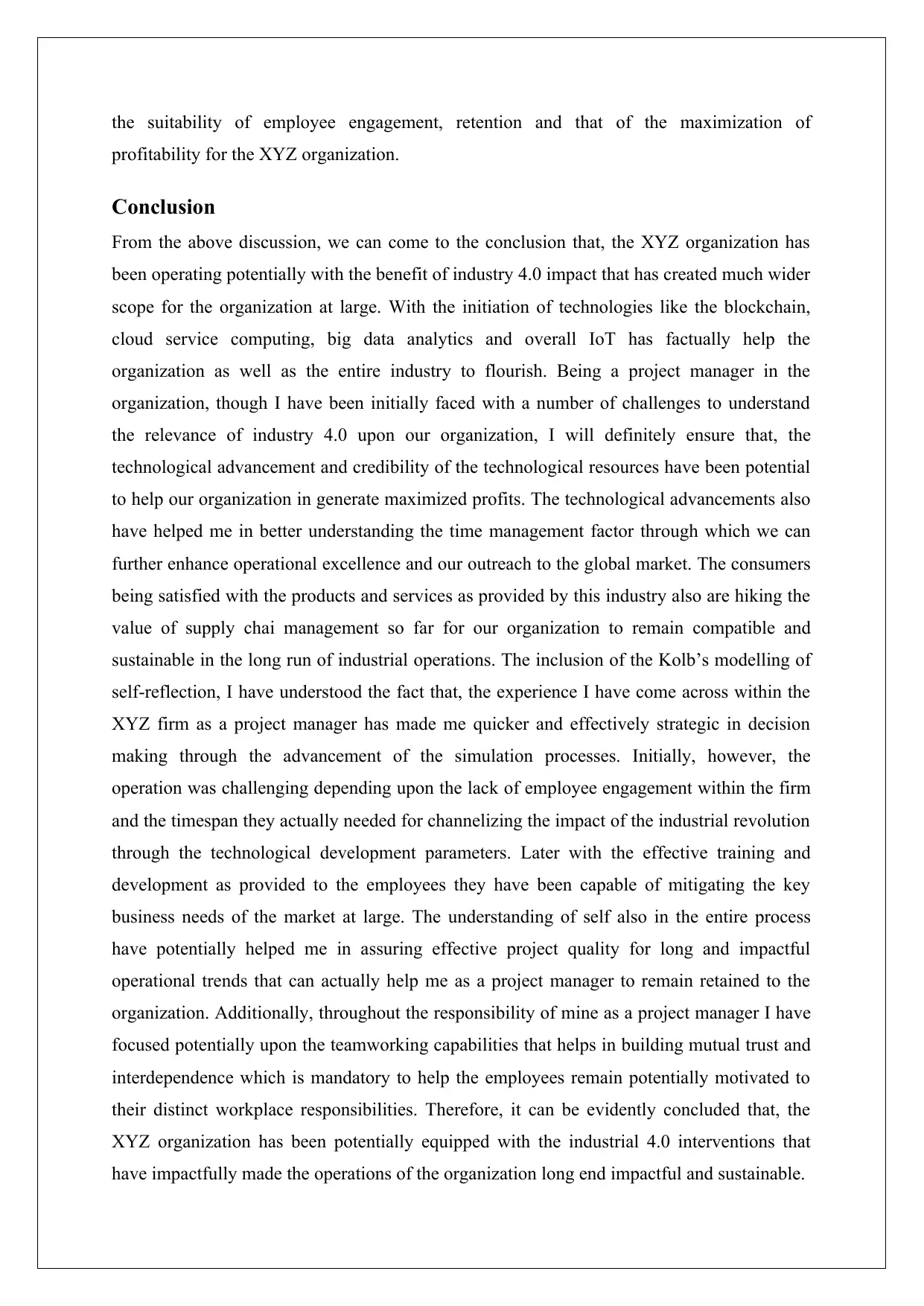
the suitability of employee engagement, retention and that of the maximization of
profitability for the XYZ organization.
Conclusion
From the above discussion, we can come to the conclusion that, the XYZ organization has
been operating potentially with the benefit of industry 4.0 impact that has created much wider
scope for the organization at large. With the initiation of technologies like the blockchain,
cloud service computing, big data analytics and overall IoT has factually help the
organization as well as the entire industry to flourish. Being a project manager in the
organization, though I have been initially faced with a number of challenges to understand
the relevance of industry 4.0 upon our organization, I will definitely ensure that, the
technological advancement and credibility of the technological resources have been potential
to help our organization in generate maximized profits. The technological advancements also
have helped me in better understanding the time management factor through which we can
further enhance operational excellence and our outreach to the global market. The consumers
being satisfied with the products and services as provided by this industry also are hiking the
value of supply chai management so far for our organization to remain compatible and
sustainable in the long run of industrial operations. The inclusion of the Kolb’s modelling of
self-reflection, I have understood the fact that, the experience I have come across within the
XYZ firm as a project manager has made me quicker and effectively strategic in decision
making through the advancement of the simulation processes. Initially, however, the
operation was challenging depending upon the lack of employee engagement within the firm
and the timespan they actually needed for channelizing the impact of the industrial revolution
through the technological development parameters. Later with the effective training and
development as provided to the employees they have been capable of mitigating the key
business needs of the market at large. The understanding of self also in the entire process
have potentially helped me in assuring effective project quality for long and impactful
operational trends that can actually help me as a project manager to remain retained to the
organization. Additionally, throughout the responsibility of mine as a project manager I have
focused potentially upon the teamworking capabilities that helps in building mutual trust and
interdependence which is mandatory to help the employees remain potentially motivated to
their distinct workplace responsibilities. Therefore, it can be evidently concluded that, the
XYZ organization has been potentially equipped with the industrial 4.0 interventions that
have impactfully made the operations of the organization long end impactful and sustainable.
profitability for the XYZ organization.
Conclusion
From the above discussion, we can come to the conclusion that, the XYZ organization has
been operating potentially with the benefit of industry 4.0 impact that has created much wider
scope for the organization at large. With the initiation of technologies like the blockchain,
cloud service computing, big data analytics and overall IoT has factually help the
organization as well as the entire industry to flourish. Being a project manager in the
organization, though I have been initially faced with a number of challenges to understand
the relevance of industry 4.0 upon our organization, I will definitely ensure that, the
technological advancement and credibility of the technological resources have been potential
to help our organization in generate maximized profits. The technological advancements also
have helped me in better understanding the time management factor through which we can
further enhance operational excellence and our outreach to the global market. The consumers
being satisfied with the products and services as provided by this industry also are hiking the
value of supply chai management so far for our organization to remain compatible and
sustainable in the long run of industrial operations. The inclusion of the Kolb’s modelling of
self-reflection, I have understood the fact that, the experience I have come across within the
XYZ firm as a project manager has made me quicker and effectively strategic in decision
making through the advancement of the simulation processes. Initially, however, the
operation was challenging depending upon the lack of employee engagement within the firm
and the timespan they actually needed for channelizing the impact of the industrial revolution
through the technological development parameters. Later with the effective training and
development as provided to the employees they have been capable of mitigating the key
business needs of the market at large. The understanding of self also in the entire process
have potentially helped me in assuring effective project quality for long and impactful
operational trends that can actually help me as a project manager to remain retained to the
organization. Additionally, throughout the responsibility of mine as a project manager I have
focused potentially upon the teamworking capabilities that helps in building mutual trust and
interdependence which is mandatory to help the employees remain potentially motivated to
their distinct workplace responsibilities. Therefore, it can be evidently concluded that, the
XYZ organization has been potentially equipped with the industrial 4.0 interventions that
have impactfully made the operations of the organization long end impactful and sustainable.
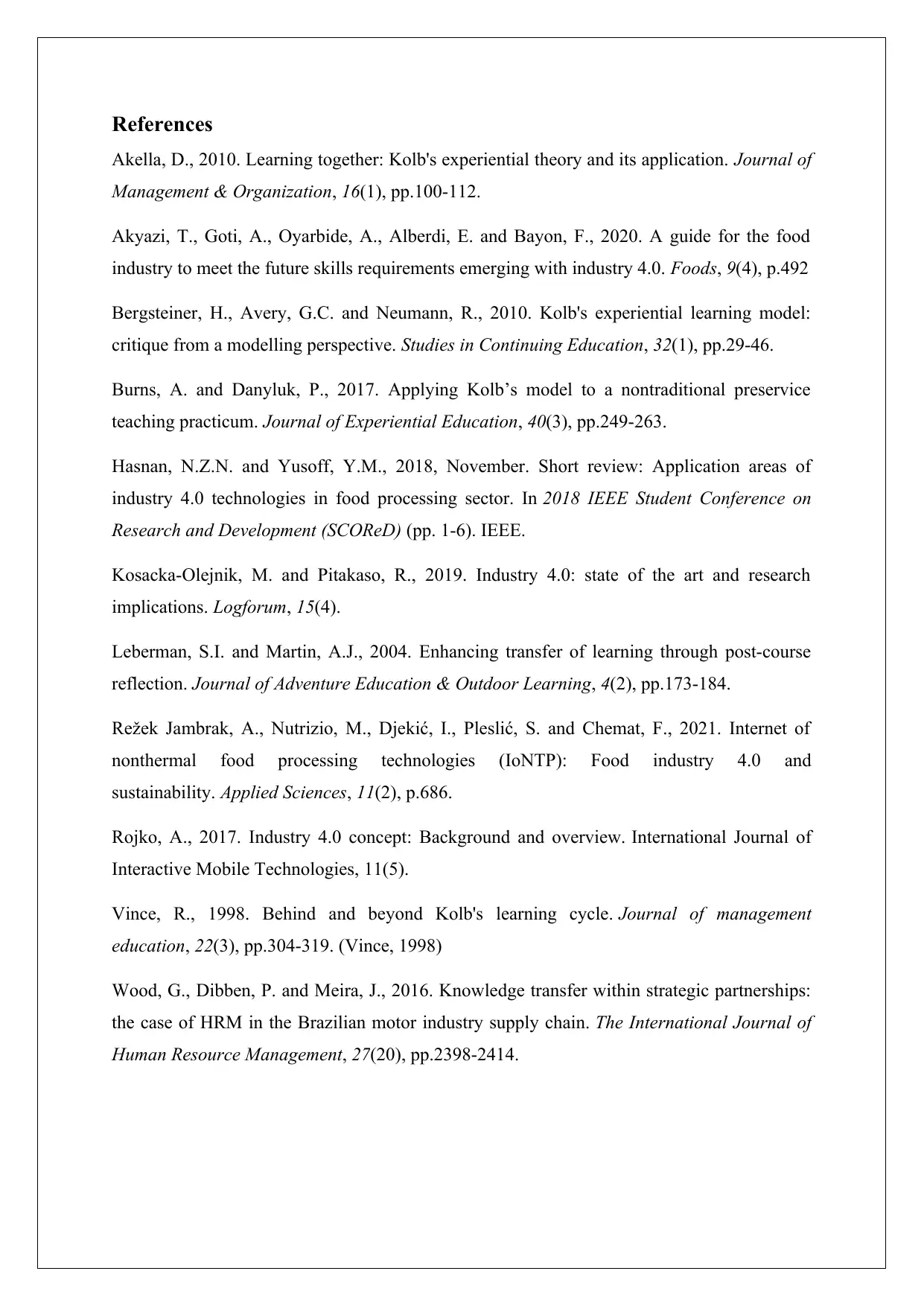
References
Akella, D., 2010. Learning together: Kolb's experiential theory and its application. Journal of
Management & Organization, 16(1), pp.100-112.
Akyazi, T., Goti, A., Oyarbide, A., Alberdi, E. and Bayon, F., 2020. A guide for the food
industry to meet the future skills requirements emerging with industry 4.0. Foods, 9(4), p.492
Bergsteiner, H., Avery, G.C. and Neumann, R., 2010. Kolb's experiential learning model:
critique from a modelling perspective. Studies in Continuing Education, 32(1), pp.29-46.
Burns, A. and Danyluk, P., 2017. Applying Kolb’s model to a nontraditional preservice
teaching practicum. Journal of Experiential Education, 40(3), pp.249-263.
Hasnan, N.Z.N. and Yusoff, Y.M., 2018, November. Short review: Application areas of
industry 4.0 technologies in food processing sector. In 2018 IEEE Student Conference on
Research and Development (SCOReD) (pp. 1-6). IEEE.
Kosacka-Olejnik, M. and Pitakaso, R., 2019. Industry 4.0: state of the art and research
implications. Logforum, 15(4).
Leberman, S.I. and Martin, A.J., 2004. Enhancing transfer of learning through post-course
reflection. Journal of Adventure Education & Outdoor Learning, 4(2), pp.173-184.
Režek Jambrak, A., Nutrizio, M., Djekić, I., Pleslić, S. and Chemat, F., 2021. Internet of
nonthermal food processing technologies (IoNTP): Food industry 4.0 and
sustainability. Applied Sciences, 11(2), p.686.
Rojko, A., 2017. Industry 4.0 concept: Background and overview. International Journal of
Interactive Mobile Technologies, 11(5).
Vince, R., 1998. Behind and beyond Kolb's learning cycle. Journal of management
education, 22(3), pp.304-319. (Vince, 1998)
Wood, G., Dibben, P. and Meira, J., 2016. Knowledge transfer within strategic partnerships:
the case of HRM in the Brazilian motor industry supply chain. The International Journal of
Human Resource Management, 27(20), pp.2398-2414.
Akella, D., 2010. Learning together: Kolb's experiential theory and its application. Journal of
Management & Organization, 16(1), pp.100-112.
Akyazi, T., Goti, A., Oyarbide, A., Alberdi, E. and Bayon, F., 2020. A guide for the food
industry to meet the future skills requirements emerging with industry 4.0. Foods, 9(4), p.492
Bergsteiner, H., Avery, G.C. and Neumann, R., 2010. Kolb's experiential learning model:
critique from a modelling perspective. Studies in Continuing Education, 32(1), pp.29-46.
Burns, A. and Danyluk, P., 2017. Applying Kolb’s model to a nontraditional preservice
teaching practicum. Journal of Experiential Education, 40(3), pp.249-263.
Hasnan, N.Z.N. and Yusoff, Y.M., 2018, November. Short review: Application areas of
industry 4.0 technologies in food processing sector. In 2018 IEEE Student Conference on
Research and Development (SCOReD) (pp. 1-6). IEEE.
Kosacka-Olejnik, M. and Pitakaso, R., 2019. Industry 4.0: state of the art and research
implications. Logforum, 15(4).
Leberman, S.I. and Martin, A.J., 2004. Enhancing transfer of learning through post-course
reflection. Journal of Adventure Education & Outdoor Learning, 4(2), pp.173-184.
Režek Jambrak, A., Nutrizio, M., Djekić, I., Pleslić, S. and Chemat, F., 2021. Internet of
nonthermal food processing technologies (IoNTP): Food industry 4.0 and
sustainability. Applied Sciences, 11(2), p.686.
Rojko, A., 2017. Industry 4.0 concept: Background and overview. International Journal of
Interactive Mobile Technologies, 11(5).
Vince, R., 1998. Behind and beyond Kolb's learning cycle. Journal of management
education, 22(3), pp.304-319. (Vince, 1998)
Wood, G., Dibben, P. and Meira, J., 2016. Knowledge transfer within strategic partnerships:
the case of HRM in the Brazilian motor industry supply chain. The International Journal of
Human Resource Management, 27(20), pp.2398-2414.
⊘ This is a preview!⊘
Do you want full access?
Subscribe today to unlock all pages.

Trusted by 1+ million students worldwide
1 out of 9
Related Documents
Your All-in-One AI-Powered Toolkit for Academic Success.
+13062052269
info@desklib.com
Available 24*7 on WhatsApp / Email
![[object Object]](/_next/static/media/star-bottom.7253800d.svg)
Unlock your academic potential
Copyright © 2020–2025 A2Z Services. All Rights Reserved. Developed and managed by ZUCOL.




